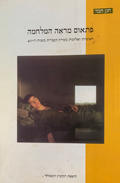
The symbol ruled 1930s and 1940s thoughts and writing of Israeli Hebrew poetry. In 1934 Avraham Shlonsky published Rough Stones, a book of poems that became the textbook of the symbolistic school of poetry that gathered around him. Nathan Alterman, Yocheved Bat-Miryam, Ezra Zusman, Yakov Orland, Lea Goldberg, Avraham Halfi, Alexander Penn, Yonatan Ratosh and others all wrote, in their own fashion musical symbolistic, precisely styled poetry, centered on the grief of modern existence as a general human stance, abstract, at times also pacifist, being realized in European spaciousness.
But with the Germans invasion into Poland on sept 1, 1939 and the beginning of World War 2, substantial and concrete dilemmas and fears rose to the surface with an undeniable force and could no longer be ignored. Fear and anxiety about the fate of European Jews and the realization that the violent eruption might lead to the unimaginable worst ignited a profound debate within the symbolistic school: facing the awful tragedy of war, should poetry enlist to further the national effort? Hebrew symbolism’s history and upheavals, described in this book, transforms at this point and then during the 1940s a discourse of violence. At the beginning of the war, symbolistic poetry was still committed to the creation of sovereign national culture, addressing the violence aimed at their own sovereign nationality. The total symbol of the “living-dead,” especially in Nathan Alterman’s “Joy of the Poor” (1941) was instrumental in constructing this collective image. But as of the end of 1942, with the growing realization that the events of the war in Europe were exceeding well beyond a terrible culmination of persecutions and killings, but that it was actually a genocide of the Jewish people, Alterman dramatically turned his orientation and published his book Plague Poems (1944), in which he deconstructed the image of the all-powerful sovereignity of Jewish nationalism. He dissimilated the poetic symbol and replaced it with an allegory, a literary figure that represents a weak collective, lacking all hope for a collective redemption, writing a narrative of genocide deviating from the Zionist sovereign story.
This innovative reading of the Plague Poems is only one of a set of readings of the Eretz-Israeli symbolistic poetics and of the power relations that it employs within the poetic structure reigning the culture and ideology during times of the Shoah and the struggle for independence. The culture of Hebrew poetry is examined as a dynamic of relations between poetry, nationalism, images of power and of conflicts – and the Zionist stance, which ruled the deliberations and literature and the literary solutions deviating from it in order to represent alternative stances. One such subversive stream which stands out is the poetry of female poets writing about the Shoah and the 1948 war using corporeal imagery to create feminine nationalism.
By exposing the cracks and clinks of mainstream Hebrew poetry, striving to slide over conflicts in national politics and culture and cover the violence arising when constructing nationalist sovereignty, this book proposes a critical observation of the mechanism of Zionist culture.